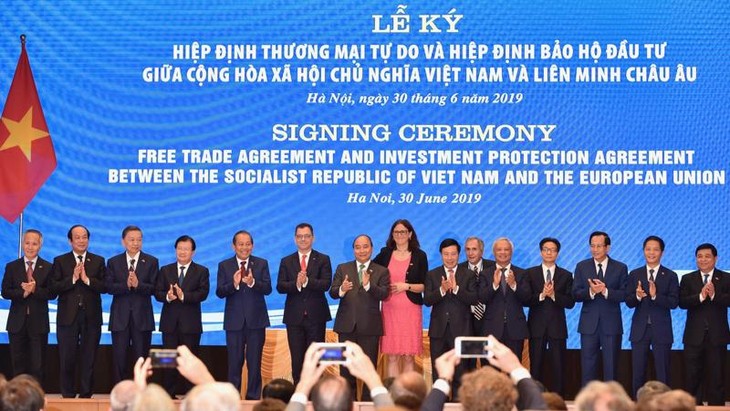(VOVWORLD) - A year after the EU-Vietnam Free Trade Agreement (EVFTA) took effect, import-export turnover has grown dramatically. But the unprecedented pressure of the COVID-19 pandemic has demanded adjustment to make the most of the opportunities the agreement has created.

The Free Trade Agreement between Vietnam and the European Union (EU) was signed in Hanoi on June 30, 2019. (Photo: VGP)
|
Effective from August 1, 2020, the EVFTA is one of the new generation free trade agreements. It allows Vietnam to connect directly with the 27 EU economies, a market with the world’s second largest purchasing power. Vietnam, a market of 98 million people and an export-oriented economy, has a high demand for input materials as well as good quality consumer products from the EU.
EVFTA and undeniable values
In the first seven months of 2020, Vietnam's exports to the EU dropped 5.9% compared to the previous year, but things have completely turned around since then under the positive impact of the EVFTA. In the first nine months of 2021, exports from Vietnam to the EU steadily increased, particularly for agricultural products. The agreement also strongly boosted imports from the EU to Vietnam. Vietnam’s export turnover enjoying preferential tariffs under EVFTA was the highest compared of any FTA during the first year of enforcement.
Tran Quoc Khanh, Deputy Minister of Industry and Trade, said: “The agreement has had very positive effects. Two-way trade grew 12% year-on-year. Our exports to the EU totaled to 38 billion USD, while the EU’s exports to Vietnam reached 16 billion USD. The turnover of products that applied for a certificate of origin to be able to enjoy the agreement preferences reached nearly 8 billion USD.”
Advantages and disadvantages identified
Despite initial success, Vietnam faced higher trade costs than other countries in the region. Impacted by the pandemic, the flow of foreign direct investment (FDI) from the EU to Vietnam has slowed down.
Le Quoc Phuong, former Deputy Director of the Industry and Trade Information Center of the Ministry of Industry and Trade, suggested ways to take advantage of the EVFTA.
“It is necessary to improve the competitiveness of enterprises by adopting long-term solutions. The support industry must be promoted. In the meantime, short-term solutions are still needed for businesses to make good use of the EVFTA incentives. But the bottom-line must still be added value and technology content in Vietnam's export products,” Mr. Phong said.
According to the Vietnam Institute for Economic and Policy Research, if enforced under normal conditions, the EVFTA could enable Vietnam's exports to earn an additional 5.5 billion USD and become an important part of the global supply chain. However, in the wake of the pandemic, Vietnam needs to consider options for repositioning itself in that value chain, with more aggressive policy solutions for building stronger production and export capacity by prioritizing added value and high tech.
“This is an opportunity for us to vigorously implement the digital economy and e-government and apply IT in businesses. To be able to increase the export rate and export value, we must process products for export instead of exporting low value added products. So, the EVFTA is not just an export opportunity but also a driver of reform, of the shift to the digital economy, and of greater business competitiveness,” according to economist Dr. Le Dang Doanh.
In the past year, what the EVFTA has brought was not always sweet. Bitter reality has emerged. But clearly identifying opportunities and challenges will help the two sides capitalize on each other's potentials and advantages.